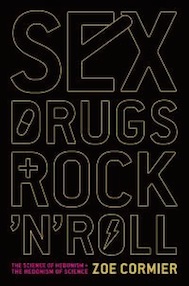By Louis J. Kern
A jaunty romp through human sensory experience as expressed in our most enduring and insatiable pleasurable impulses—hallucinogens and pain killers, non-reproductive sex, and rhythm and melody—this work stylistically resembles Mary Roach’s Bonk: The Curious Coupling of Sex and Science (2009). Cormier is a member of the Guerilla Science collective that brings science to the public through playful “happenings” combining information with entertainment. A recent event, Sensory Speed Dating (April 2015), for example, explored the role of the senses in sexual attraction through blindfolded interaction with strangers.
Cormier’s approach embraces the collective’s intent to revolutionize popular experience of science. Filled with fascinating facts and oddities of animal and human behavior, the text embodies a serious consideration of the chemical and neurological functions of the brain and an exploration of the range and limits of sensory experience while addressing the fundamental scientific questions: Are we the products of nature or nurture? and, What is it that essentially makes us human?
In the section on sex, Cormier demonstrates how the senses affect the primary sex organ—the brain. She considers the study of human sexual behavior from Kinsey to Masters and Johnson to evolutionary biologists with a side excursion into the monkey gland surgery of Serge Voronoff. At times there is some carelessness with details. Kinsey was not a lepidopterist but a hymenopterist, studying gall wasps. She misstates the purpose of “pink Viagra” as enhancing female orgasm rather than intensifying desire.
The sections on drugs and music are more directly concerned with neuroscience and chemistry and demonstrate how recreational drugs and popular music, while initially used as agents of control and entertainment, have led to important scientific discovery. Apart from the well-known self-administered experimentations of Sigmund Freud with cocaine, Cormier references the military’s use of mescaline and LSD (the MKUltra project [1950s]) to reprogram the minds of psychiatric patients. Psychiatrists experimented with LSD in the 1950s as an antidote to alcoholism, and big pharma is currently considering the potential of psychedelics to treat depression and PSTD.
Scientific investigation has relied on recreational users’ experiences, in turn made possible by widespread drug dissemination through the work of chemists Albert Hoffman (LSD), and Alexander Shulgin (MDMA), and psychiatrist Timothy Leary (LSD). The music section emphasizes popular musicians’ development of recording technology as a catalyst for the emergence of therapeutic uses of music in neuroscience and psychiatry. Of particular note here is Oliver Sacks’ Musicophilia: Tales of Music and the Brain (2007), as well as the more anecdotal intellectual enhancement through music that Cormier calls the “Judas Priest effect.”
Despite the wealth of entertaining and instructive detail provided here, however, the volume shares a bias towards human biological singularity that has long characterized the quest for the primary characteristic of human uniqueness.
While Cormier acknowledges non-reproductive sex among our Pongidae cousins, she asserts that “we probably experience more pleasure from sex than any other form of life that has ever existed,” and largely ignores the extensive work on animal sexuality that has demonstrated an animal counterpart to every form of human sexual practice, as illustrated in Bruce Bagemihl’s Biological Exhuberance: Animal Homosexuality and Natural Diversity (1999). Animals’ usage of the natural pharmacopeia and their response to the rhythmic elements of music are also overlooked here.
The discovery of something unique about the human brain and consciousness may yet be discovered, but the thrust of much of contemporary science has been to reveal our closer kinship to the broader biota of the planet.
Louis J. Kern (ΦBK, Clark University, 1965) is professor emeritus of history at Hofstra University. Hofstra University is home to the Omega of New York Chapter of Phi Beta Kappa.




